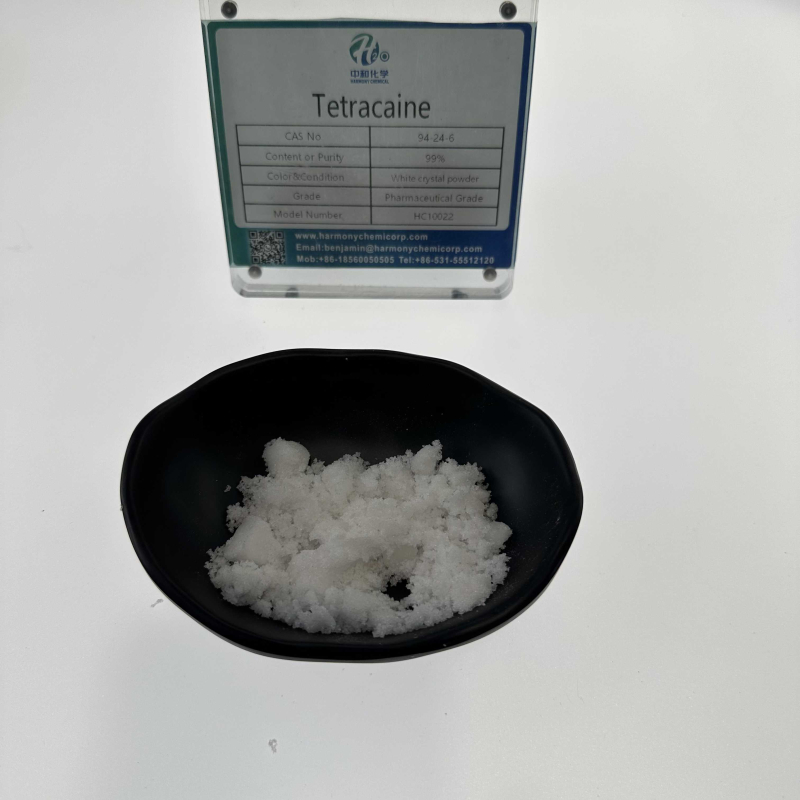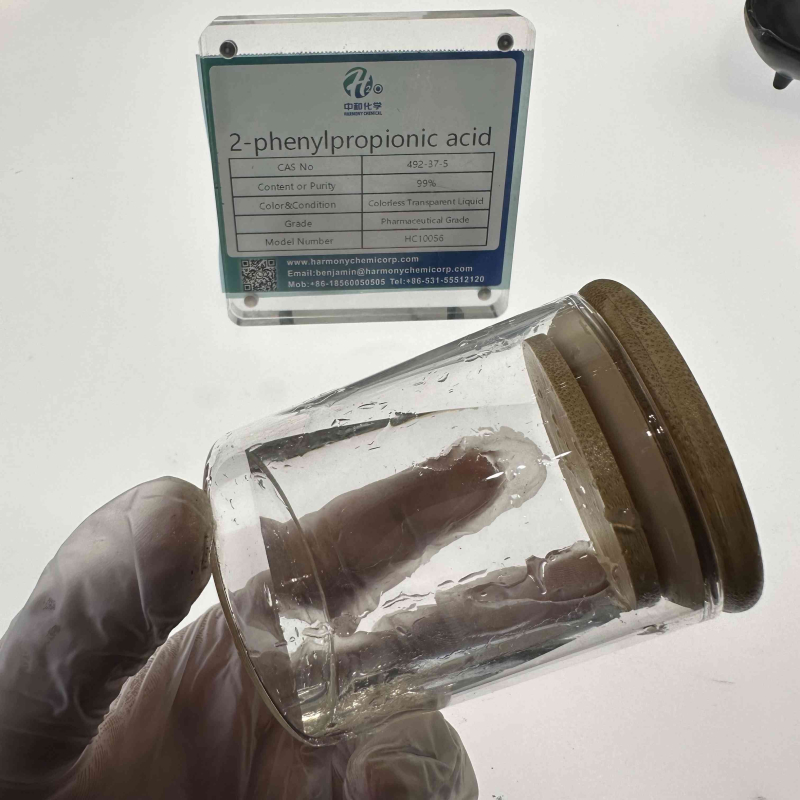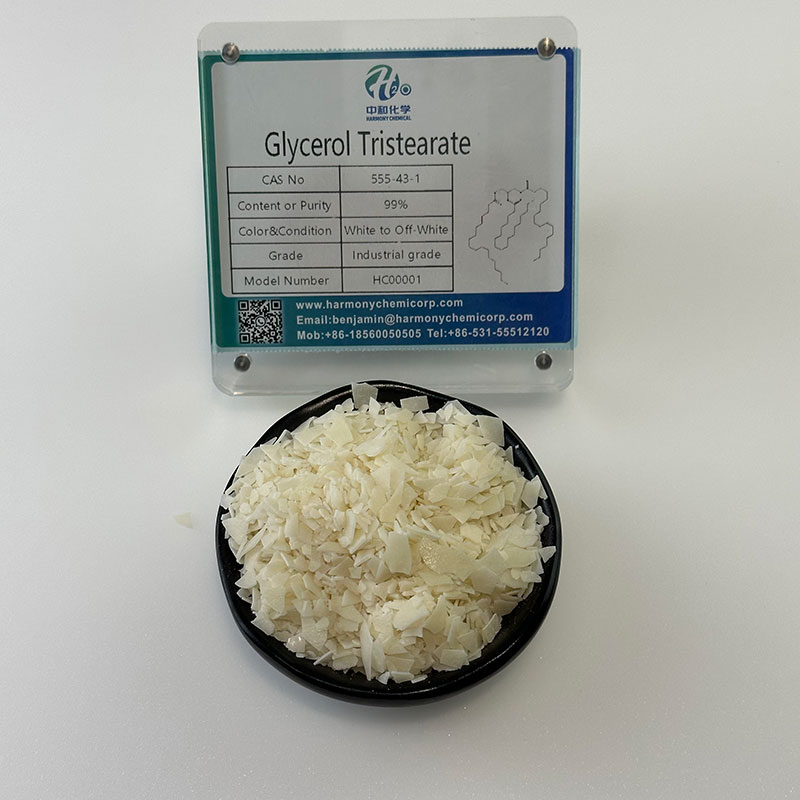namePropitocaine hydrochlorideCAS NO1786-81-8Molecular formulaC13H21ClN2Omolecular weight256.77melting point168-170°CStorage conditions2-8°CsolubilityFreely soluble in water and in ethanol (96 per cent), very slightly soluble in acetoneformneatcolourWhite to Off-WhitePrilocaine hydrochloride is a kind of local anesthetic of aminoamide. Pirocaine is commonly used in dentistry. Procaine is also often used in combination with Lidocaine as a preparation for skin anesthesia (Lidocaine/Procaine or EMLA) to treat sensory abnormalities and other conditions.
Contact Now
Epidural AdministrationofRopivacainehydrochloride monohydrate effectivelyblockneuroethicpain(bothmechanicalallodyniaandheathyperalgesia)withoutinductionfanalgesictoleranceandsignificantlydelaystheevelopment ofneuropathicpain producedbyperipheral nervenjury.Ropivacainehydrochloride inhibitionpressure-inducedincreasesinfiltrationcoefficient(Kf)withoutaffectingpulmonaryarterypressure (Ppa), Pulmonary capillary pressures(Ppc),andzonalcharacteristics(ZC).Ropivacaine hydrochloride monohydrate preventspressure-induced lungedemansociatedhyperpermeability yasevidencebymaintainingPaO2,lungwet-to-dryrati
Contact Now
Tetracaine hydrochloride is used for mucosal floor anesthesia, conduction anesthesia, epidural anesthesia, and subarachnoid anesthesia; Used for ophthalmic floor anesthesia, barring constricting blood vessels, detrimental corneal epithelium, and growing intraocular pressure.nameTetracaine hydrochlorideCAS NO136-47-0Molecular formulaC15H25ClN2O2melting point149°Cdensity1.1279 (rough estimateStorage conditions2-8°Csolubilityalcohol: solublesoluble 40 parts of solventformneatcolourWhite to Almost whiteSOLUBLESoluble in water at 50mg/ml
Contact Now
nameUrapidil hydrochlorideCAS NO64887-14-5Molecular formulaC20H30ClN5O3molecular weight423.94melting point156-1580CStorage conditionsKeep in dark place,Inert atmosphere,Room temperaturesolubilityH2O: solubleformsolidcolourwhiteSOLUBLESoluble to 50 mM in water
Contact Now
nameLevamisole hydrochlorideCAS NO16595-80-5Molecular formulaC11H13ClN2Smolecular weight240.75melting point266-267 °Cflash point9℃Storage conditions2-8°Crefractivity-126 ° (C=1, H2O)formCrystalline PowdercolourWhite to almost white
Contact Now
melting point86-88 °C(lit.)Storage conditions2-8°CformPowdercolourWhite to off-whitepH value4.0 to 6.5(50g/L, 25 ℃)SOLUBLEsolubleCAS NO1670-14-0Molecular formulaC7H9ClN2molecular weight156.61EINECS number216-795-4
Contact Now
nameLinocaine hydrochlorideCAS NO6108-05-0Molecular formulaC14H25ClN2O2molecular weight288.82melting point75-79℃Storage conditions2-8°CsolubilityH2O: solubleformsolidcolourwhiteSOLUBLESoluble in water (50 mg/ml), chloroform, ethanol, and benzene. Insoluble in diethyl ether.
Contact Now
nameDapoxetine hydrochlorideCAS NO129938-20-1Molecular formulaC21H24ClNOmolecular weight341.88melting point175-1790CStorage conditionsroom tempformpowdercolourwhitesolubilityDMSO: ≥20mg/mL
Contact Now
nameEsmolol hydrochlorideCAS NO81161-17-3Molecular formulaC16H26ClNO4molecular weight331.83melting point48-50°Cdensity1.026Storage conditions−20°CsolubilityH2O: soluble12mg/mLformbuffered aqueous solutioncolourWhite to Off-White
Contact Now
namePramoxine hydrochlorideCAS NO637-58-1Molecular formulaC17H28ClNO3molecular weight329.86melting point181-183°Storage conditionsInert atmosphere,Room TemperaturesolubilityChloroform (Slightly), Methanol (Slightly)formneatcolourWhite to Off-White
Contact Now
Melting Point180-185 °C(lit.)Density1.18 g/mL at 25 °C(lit.)Refractivityn20/D 1.465Storage Conditionsroom tempSolubilityH2O: 6 M, clear, colorlessFormCrystalsColourWhite to slightly yellowPh Value4.5-5.5 (100g/l, H2O, 20℃)1. It can be used as an intermediate in medicine, pesticides, dyes, and different natural synthesis.
Contact Now
name5-FluorouracilCAS NO51-21-8Molecular formulaC4H3FN2O2molecular weight130.08boiling point190-200°C/0.1mmHgdensity1.4593 (estimate)Storage conditions2-8°CsolubilityH2O: 10 mg/mL, clearformpowdercolourwhite
Contact Now
nameTofacitinibCAS NO477600-75-2Molecular formulaC16H20N6Omolecular weight312.38density1.3Storage conditions-20°CsolubilitySoluble in DMSO (up to 100 mg/ml) or in Ethanol (up to 100 mg/ml).formPale powder.Acidity coefficient (pKa)6.04±0.60(Predicted)colourOff-white
Contact Now
nameTrilostaneCAS NO13647-35-3Molecular formulaC20H27NO3molecular weight329.43melting point264 °Cboiling point467.02°C (rough estimate)density1.1213 (rough estimate)Storage conditions2-8°Cformpowdercolourwhite to tan
Contact Now
The conductivity of carbon black is carefully associated to its shape (especially graphite microcrystalline structure), floor properties, and particle size. The conductive mechanism of carbon black in rubber often consists of conductive channel and Field electron emission mechanism. The conductive channel mechanism is that carbon black aggregates come into contact with every different in the adhesive to structure a community like channel and behavior electricity.
Contact Now
nameTetracaineCAS NO94-24-6Molecular formulaC15H24N2O2molecular weight264.36melting point41.0 to 45.0 °Cboiling point407.59°C (rough estimate)Storage conditions2-8°CAcidity coefficientpKa 8.33±0.03(H2O
t = 20.0
I = 0.10 (KCl)) (Uncertain)formpowder to crystalcolourWhite to Almost whiteIntroduction: Dicaine is a white crystalline or crystalline powder, odorless, slightly bitter in taste, and has a tingling sensation. Soluble in water, soluble in ethanol, insoluble in ether or benzene.
Contact Now
Mercaptopropionic acid is an organic compound with the chemical formula C3H6O2S. It is a transparent liquid with a strong sulfide odor, foul odor, and toxicity.
Contact Now
AppearanceAmber obvious liquidSolid content% ≥ 40.0Density (20 ℃)g/cm3 ≥ 1.20PH fee (1% aqueous solution)9.0-11.0Solubility15gPolyaspartic acid (PASP) belongs to a crew of polyamino acids. Polyaspartic acid is susceptible to breakage due to the motion of microorganisms, fungi, and different factors, ensuing in the degradation of environmentally pleasant ammonia, carbon dioxide, and water. Therefore, polyaspartic acid has a extensive vary of uses.
Contact Now
CAS NO492-37-5Boiling point260-262 °CDensity1.1 g/mL at 25 °Cflash point>230 °FStorage conditionsSealed in dry,Room TemperatureFormLiquidColourClear pale yellow to yellowpH value3 (5g/l, H2O, 20℃)SOLUBLE10 g/L (20 ºC)Molecular formulaC9H10O2
Contact Now
Chinese nameSodium oleateChinese aliascis 9-octadecenoic acid sodium salt; (Z) -9-octadecenoic acid sodium salt -9-octadecenoic acid sodium salt; 9-Octadecylic acid sodium; Sodium octadecene; (Z) -9-Octadecylic acid sodium salt;English nameSODIUM OLEATEEnglish aliascis Oleate sodium salt; Cis-9-Octadecenoic acid sodium salt, Oleic acid sodium salt; Eurol; Pionin D 951P; Oleic Acid Sodium Salt;CAS number143-19-1Molecular formulaC18H33NaO2Molecular weight304.44300Precision quality304.23800PSA40.13000Sodium oleate, additionally acknowledged as sodium octadecene, cis 9-octadecenol,
Contact Now
Oil soluble nano iron 1% - 10%, naphthenic acid 5% - 25%, barium naphthenate 10% - 30%, polyisobutene succinimide 5% - 10%, long-chain fatty acid 1% - 5%, and the relaxation is solvent. The instruction technique is as follows: add naphthenic acid drill, barium naphthenate, oil soluble nano iron and long-chain fatty acid into the solvent in flip at room temperature in accordance to the ratio, stir evenly, and then add polyisobutylene succinimide to stir evenly.
Contact Now
purposeHexafluorozirconate is often used to make optical glass and fluorozirconate.Used for metallic floor therapy and cleaning, as nicely as for the manufacturing of wool, leather-based garb industry, atomic electricity industry, superior electrical materials, and refractory materials.Used for metallic surfaces and coatings.
Contact Now
ApplicationsGlyceryl tristearate is an ester derivative, which can be used as food emulsifier, brightener, greasing agent, lubricant, defoamer, and also in various cosmetics.ToxicityIt is safe within the limits mentioned above (FDA, 2000).Use limitAs a crystallization catalyst for cocoa butter 1%; as a molding aid 0.5% to 3%; as a winterizing treatment agent for fats and oils 0.5% (FDA §172.811, 2000). Can be used as gum gum-based substance (GBChemicalbook2760-96).Chemical propertiesColorless crystal or powder. Odorless. Slightly sweet. Relative density (d480) 0.862.
Contact Now
nameFlorfenicolCAS NO73231-34-2Molecular formulaC12H14Cl2FNO4Smolecular weight358.21melting point153 °CSpecific Rotation26 +17.9° (DMF)boiling point618℃Storage conditionsInert atmosphere,2-8°CformsolidcolourWhite to Off-White
Contact Now





























